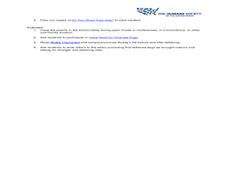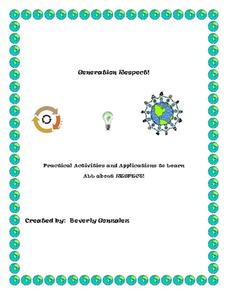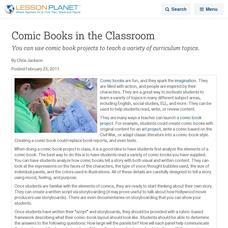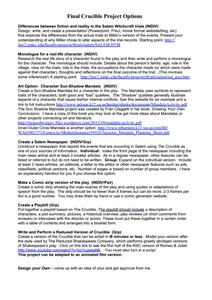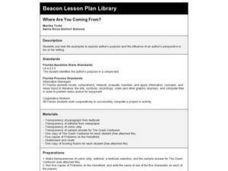Curated OER
Poetic Justice: Understanding the Life of a Tethered Dog
The Humane Society provides a lesson in which class members explore the issue of tethering dogs. Through the resources used -- a comic, a poem, and narrative and expository writings -- class members realize that messages can be conveyed...
Curated OER
Metaphor and Metonymy
If you are teaching metaphors in your language arts class, consider using this presentation to illustrate several examples of classic metaphors. Body metaphors, war metaphors, and comic metaphors all help learners understand the...
Spreading Gratitude Rocks
Generation of Respect
R.E.S.P.E.C.T. Learners find out what it means to them. Scholars write sentences, do a word sort, and list what makes them grateful. Additionally, pupils learn how to be more respectful by completing worksheets that would make Aretha...
Curated OER
Interative History Notebook Mini-lesson
Students respond to Holocaust literature. In this interactive history lesson, students select quotes from chapter 1 of Elie Wiesel's Night and reflect on their meaning as they record their thoughts on poetic, prose, comic. or picture form.
Curated OER
Women's Votes, Women's Voices
Students investigate Women's Suffrage by analyzing images from the past. In this equal rights lesson, students read biographical work about Emma Smith DeVoe, an activist who fought for women's rights. Students view a comic style...
Curated OER
From Ground to Water
Learners explore groundwater and issues relating to groundwater. They discus the problems involving groundwater. Students write a newspaper story addressing groundwater problems. They create a comic strip addressing groundwater...
Curated OER
Comic Books in the Classroom
You can use comic book projects to teach a variety of curriculum topics.
Curated OER
What Makes Jokes Funny?
Explore how language is used for comic effect. Middle schoolers determine which of the three formulas for jokes (double meanings, unexpected outcome, humorous mental image) make each of 18 classic, corny examples funny. They complete a...
Curated OER
Final Crucible Project Options
Finding and/or designing a menu of equally weighted synthesizing projects to end a unit can be a challenge. Simplify the task with this menu of individual and group projects meant to accompany a study of The Crucible. Presentations,...
University of Kansas
Newspaper in the Classroom
Newspapers aren't only for reading—they're for learning skills, too! A journalism unit provides three lessons each for primary, intermediate, and secondary grades. Lessons include objectives, materials, vocabulary, and procedure, and...
Curated OER
Practical Writing in the Intermediate Grades
Learners discuss lists of interesting topics on which to write. They explore those things that interest them, excite them and express themselves freely. They organize the value of their own thoughts and use their individual lists that...
NASA
The Big Climate Change Experiment Lesson 2: The Influence of Climate on Culture
No conversation about culture is complete without considering climate. Scholars first view videos of climate witnesses who describe the climate in their regions and how climate change affects their daily lives. They then write essays or...
K20 LEARN
It’s Raining Whats and Whats? Colloquial Language
"Yuns betta outten the lights!" Colloquial language is the focus of a instructional activity that asks middle schoolers to consider the pros and cons of using idioms. They read articles, match expressions with their meaning and place of...
Curated OER
Narrative Cartoons
Students create narrative cartoons based on the activities of the Peace Corps. For this narrative cartoons lesson plan, students create comic strips where they draw and write about various activities that the Peace Corps is involved in.
Curated OER
What are Onomatopoeias?
Sixth graders identify and define onomatopoeias using a SMART Notebook embedded with the magic eraser, magic mirror and magic glasses. For the final product, Students create either a comic strip with examples of onomatopoeias.
Curated OER
New Year's Etymology and Writing Activity
Students investigate the history and etymology of New Year's Day. They listen to a teacher-led lecture about the background of New Year's Day, design an image of Janus, and write a story in the first person telling what Janus might say...
Australian Centre For the Moving Image
Dreamworks Animation Character Design
Dive into animation creation using Dreamworks® animated films. Compare and contrast characters, wonder and ponder why the plot is so important, and think of background and themes as your creativity unrolls onto paper.
Curated OER
Jokes And Riddles
In this writing worksheet, students first select a collection of jokes and riddles to read. Students complete 4 activities: illustrating jokes, making a matching game with riddles and answers, making a comic strip, and telling a joke...
Curated OER
Where Are You Coming From?
Pupils examine and discuss author's purpose and the influence of an author's perspective in his or her writing. In groups, they read scenarios and respond to them from the perspective of a designated character. Materials are attached.
Curated OER
"Book Report Gallery" Bulletin Board
Read all about it! A camera is all you need to create a fun bulletin board promoting books. Take pictures of readers holding their favorite books and position comic-book style talk bubbles over the pictures. Created with markers and...
Curated OER
Proud to Recycle Worksheet
In this recycling activity, learners put a check mark next to the items from a list that are recycled in their local area. They determine which items are curbside recyclables and which are drop-off items. They examine pictures of...
Curated OER
How Logical is Garfield?
Third graders analyze comics found in the newspaper for samples of logical, emotional, and ethical appeal. They write a paragraph for each selected comic strip explaining how the comic strip represents the use of logic, emotions, or ethics.
Curated OER
Onomatopoeia
In this onomatopoeia worksheet, students read the directions and examples for this literary device. Students brainstorm, then write some sentences. Finally they write a comic strip using onomatopoeia, and illustrate it.
Virginia Department of Education
Laboratory Safety and Skills
Avoiding lab safety rules will not give you super powers. The lesson opens with a demonstration of not following safety rules. Then, young chemists practice their lab safety while finding the mass of each item in a mixture and trying to...
Other popular searches
- Writing Comics
- Creative Writing Comic Strips
- Esl Comic Strip Writing
- Writing a Comic Strip
- Writing Comic Strips
- Ell Comic Strip Writing


